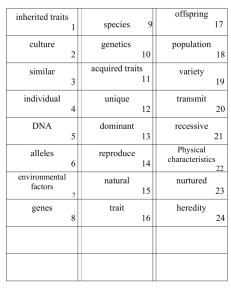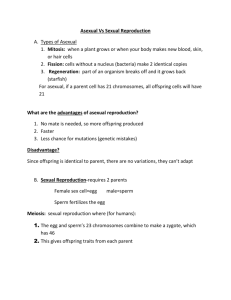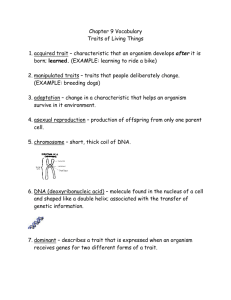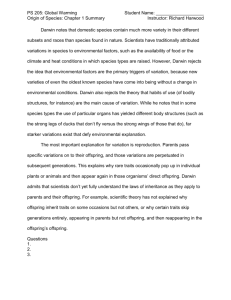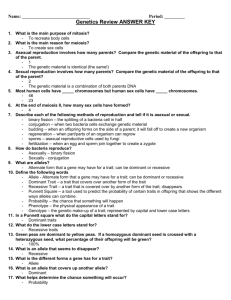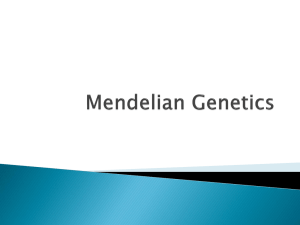CELLS
advertisement
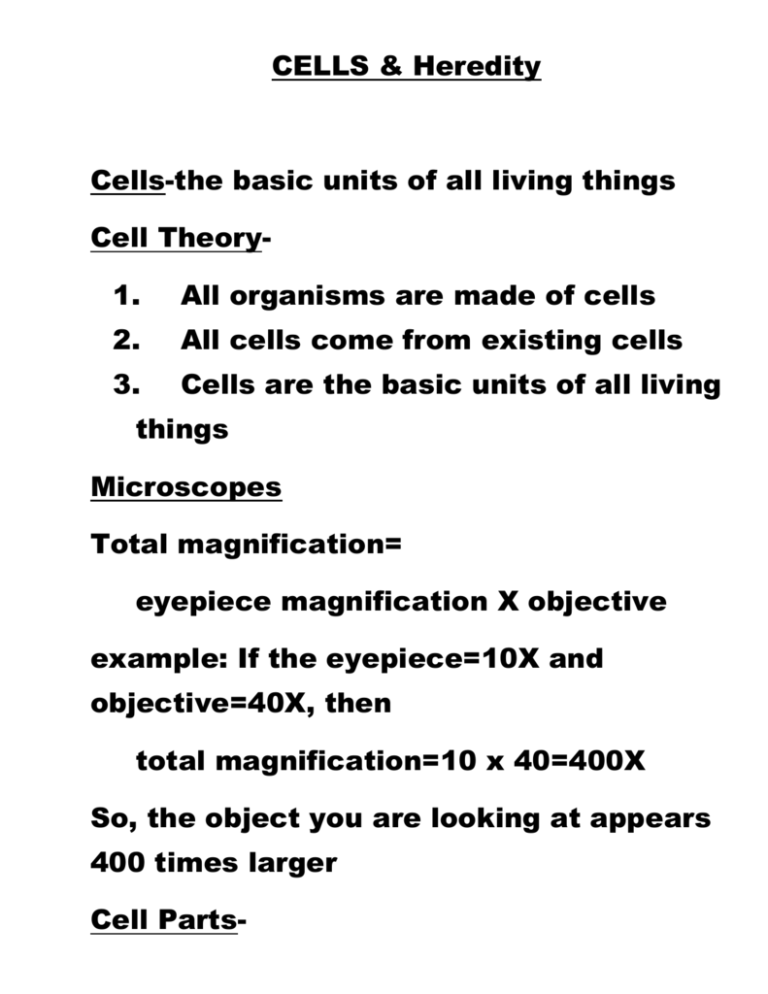
CELLS & Heredity Cells-the basic units of all living things Cell Theory1. All organisms are made of cells 2. All cells come from existing cells 3. Cells are the basic units of all living things Microscopes Total magnification= eyepiece magnification X objective example: If the eyepiece=10X and objective=40X, then total magnification=10 x 40=400X So, the object you are looking at appears 400 times larger Cell Parts- 1. Cell membrane-thin layer that holds cell together 2. Cell wall-protects and supports plant cells only 3. Nucleus-control center; DNA is here 4. Mitochondria-powers the cell, releases energy from food 5. Ribosomes-makes proteins 6. Lysosomes-break down food, digests waste 7. Golgi-packages materials 8. Endoplasmic Reticulum (ER)- carries materials around the cell Cell membrane-selectively permeable (allows some things to pass through it) *Allows-water, oxygen, carbon dioxide *Stops or limits-sugars and salts No energy is needed for: Diffusion-movement from higher to lower concentration Osmosis-diffusion of water Active transport-movement through membrane that requires energy, from low to high concentration Photosynthesis-process by which plant cells capture light energy to make food Carbon dioxide + water + lightoxygen + sugar (glucose) Chlorophyll-green pigment in plants that absorb light Most leaves are flat and wide so they can absorb more light energy. Almost all organisms get their energy directly or indirectly from the sun. Plants get it directly; others get it from eating plants or animals Respiration-In animals, cells use glucose for energy Oxygen + glucosewater + carbon dioxide + energy Photosynthesis can be thought of as the opposite of respiration. Bacterial Cells-has cell wall & membrane, but no nucleus Some cause disease, but many are helpful (digestion) Chromosome: in the nucleus, contains DNA (determine traits) Trait: characteristic of an organism (color, shape, etc) Asexual Reproduction- one parent cell splits to make 2 new cells (offspring); offspring will have the exact same DNA as the parent Types of Asexual 1.Mitosis: when a plant grows or when your body makes new blood, skin, or hair cells 2.Fission: cells without a nucleus (bacteria) make 2 identical copies 3. Regeneration: part of an organism breaks off and it grows back (starfish) For asexual, if a parent cell has 21 chromosomes, all offspring cells will have 21 Sexual Reproduction-requires 2 parents Female sex cell=egg male=sperm Sperm fertilizes the egg Meiosis: sexual reproduction where (for humans): 1. The egg and sperm’s 23 chromosomes combine to make a zygote, which has 46 2. This gives offspring traits from each parent **What are the advantages of asexual reproduction? 1. No mate is needed, so more offspring produced 2. Faster 3. Less chance for mutations (genetic mistakes) Disadvantage? Since offspring is identical to parent, there are no variations, they can’t adapt **What is the advantage of sexual reproduction? Genes from 2 parents make adaptation easier Disadvantages ? 1. A mate is needed 2. Males can’t reproduce 3. Mutations are possible Specialized Cells-cells that combine to form tissue (muscle cells form muscle) 1. Similar cells combine to make tissue 2. Similar tissues combine to make an organ 3. Organs that work together make an organ system 4. Organ systems work together to make an organism Heredity-passing of traits from parents to offspring Genetics-the study of how traits are passed Gene-basic unit of inheritance, passed from parents to offspring, determines traits Trait-characteristic or feature of an organism (eye color) DNA-chemical in nucleus that contains the code that tells an organism how to grow and function (looks like a twisted ladder, contains proteins) Alleles-different forms of traits that make up a gene pair; represented by upper and lower case letters Gregor Mendel’s Pea Plant Experiment (1800’s) Dominant: form of a trait that shows and prevents the Recessive form from being seen For pea plantsTall is dominant and short is recessive T=Tall t=short (these are the alleles for height) Homozygous (Purebred)=TT or tt Heterozygous (Hybrid)=Tt Genotypes are the letters (TT, Tt, tt) Phenotypes are the traits (Tall, short) Pedigree Chart- diagram that shows the phenotypes of a gene and its ancestors from one generation to the next (filled in means they have the trait) This example is for Righthandedness (dominant) and Lefthandedness (rec.) Conclusion for Toothpick Fish Activity: Green adapted to be dominant because it was camouflaged by algae. When the river was polluted, algae died and green fish were easy prey. Eventually, another color will become dominant! People from different parts of the world can still be so much alike genetically that they can use blood or organs from another person. BUT, people from one area can be different in their skin color, size and personality because of genetics, their surroundings, nutrition, or how they are raised.



